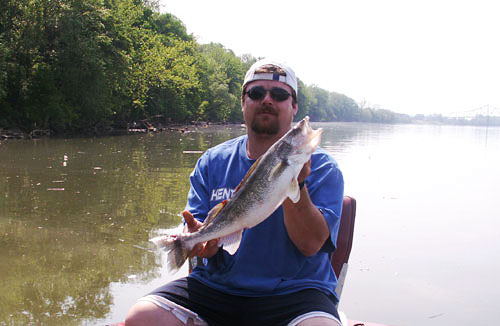
Editor’s Note: This column first appeared in The Greater Ashland Beacon on July 20, 2011 and is being published here with permission.
By Chris Erwin
ASHLAND As I sit here looking out over the Ohio River, I can’t help but to think about it in the days when I grew up and how much it has changed. Most of the time when people think back to “the good old days” they remember how much better it was when they were young and how things have changed for the worst.
I’m happy to report that back in the “good old days” the river was a mess; it has come a long way for the better. I remember, as a boy back in the 50’s, the river being heavily polluted with oil and this tar looking stuff that smelled like asphalt. When the water would get high it hung from the trees like black spider webs and at the edge of the bank where the water washed back and forth it looked like black sand from a distance but once you got close the true nature of it became clear. I remember too that small little round balls of black oil and tar washed in and out as the waves from boat traffic agitated the water.
No one was bass fishing the river back then and most people wouldn’t even think about swimming in it, of course as a young boy, I had no reservations about jumping in even though I smelled like road kill once I got out.
Today with the increased regulations against dumping, the river has rebounded to a large degree. The oil is gone and the fishery has become one that gets national attention. Bass, crappie, white bass, walleye, sauger, catfish, hybrids, and smallmouth have all made comebacks thanks to the efforts of state and federal Departments of Fish and Wildlife.

They are still two pollutants that remain of concerned in many waters of Kentucky. They are mercury and PCBs. Mercury is found in many rocks, including coal, and when coal is burned, mercury is released into the environment.
According to the EPA, coal-burning power plants are the largest human-caused source of mercury emissions to the air in the United States, accounting for over 50 percent of all domestic human-caused mercury emissions. All waters in Kentucky are under advisory for mercury. Women of childbearing age and children six years of age or younger should eat no more than one meal per week of freshwater fish. Adult men and other women are not included in the consumption notice.
This is not an emergency as organic mercury can also occur naturally in the environment and does not affect swimmers, skiers or boaters. Fish can accumulate these low levels of mercury by eating plankton and other small aquatic creatures.
The other pollutant PCBs (Polychlorinated Biphenyls) was used as a dielectric and coolant fluid in things like transformers, capacitors and electric motors. Due to the toxicity, it was classified as a persistent organic pollutant and Congress banned its production in 1979.
Today, the Ohio River is approaching the same water quality as many of the other bodies of water in Kentucky and while it still has consumption advisories, fish like the white crappie are listed as unlimited for general public consumption.
While most lakes become very hot in summer, the river is one place where the fishing is usually still good. Fish with crank baits and jigs in the mouth of coves and around docks and bridges in the early morning and late evening, and your chances are good that you will find some action.
Breaking fish like white bass are still active this time of year.
Below the Greenup Dam reports of small mouth action has been on the increase for the last few years.
The future for the Ohio River is bright; cities up and down the river have realized the economic potential of recreation. The completion of our own riverfront is just one example of how the mighty Ohio has rebounded as a destination due to better stewardship of our natural resources along with the investment of communities in this potential recreational playground.
Till Next Time,
Good Fishing.
Chris Erwin is the founder and publisher of Kentucky Angling News, an outdoor magazine available at www.kentuckyangling.com To reach Chris e-mail him at trimmer308@windstream.net


Be the first to comment